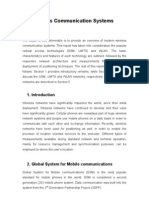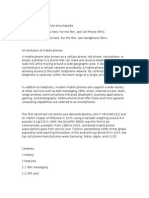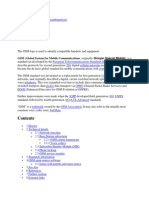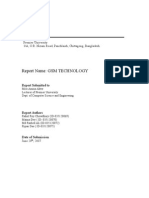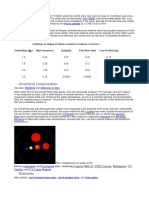POP3
Uploaded by
jafasoh293POP3
Uploaded by
jafasoh293Cellular systems[edit]
Main articles: Cellular network and Cellular frequencies
Mobile phone subscriptions, not subscribers, per 100
inhabitants 1997-2007
Mobile phones receive and send radio signals with any number of cell site base stations fitted with microwave antennas. These sites are usually
mounted on a tower, pole or building, located throughout populated areas, then connected to a cabled communication network and switching system.
The phones have a low-power transceiver that transmits voice and data to the nearest cell sites, normally not more than 8 to 13 km (approximately 5 to
8 miles) away. In areas of low coverage, a cellular repeater may be used, which uses a long-distance high-gain dish antenna or yagi antenna to
communicate with a cell tower far outside of normal range, and a repeater to rebroadcast on a small short-range local antenna that allows any
cellphone within a few meters to function properly.
When the mobile phone or data device is turned on, it registers with the mobile telephone exchange, or switch, with its unique identifiers, and can then
be alerted by the mobile switch when there is an incoming telephone call. The handset constantly listens for the strongest signal being received from
the surrounding base stations, and is able to switch seamlessly between sites. As the user moves around the network, the "handoffs" are performed to
allow the device to switch sites without interrupting the call.
Cell sites have relatively low-power (often only one or two watts) radio transmitters which broadcast their presence and relay communications between
the mobile handsets and the switch. The switch in turn connects the call to another subscriber of the same wireless service provider or to the public
telephone network, which includes the networks of other wireless carriers. Many of these sites are camouflaged to blend with existing environments,
particularly in scenic areas.
The dialogue between the handset and the cell site is a stream of digital data that includes digitised audio (except for the first generation analog
networks). The technology that achieves this depends on the system which the mobile phone operator has adopted. The technologies are grouped by
generation. The first-generation systems started in 1979 with Japan, are all analog and include AMPS and NMT. Second-generation systems, started
in 1991 in Finland, are all digital and include GSM, CDMA and TDMA.
The GSM standard is a European initiative expressed at the CEPT ("Conférence Européenne des Postes et Telecommunications", European Postal
and Telecommunications conference). The Franco-German R&D cooperation demonstrated the technical feasibility, and in 1987 a Memorandum of
Understanding was signed between 13 European countries who agreed to launch a commercial service by 1991. The first version of the GSM (=2G)
standard had 6,000 pages. The IEEE/RSE awarded to Thomas Haug and Philippe Dupuis the 2018 James Clerk Maxwell medal for their contributions
to the first digital mobile telephone standard.[16] In 2018, the GSM was used by over 5 billion people in over 220 countries. The GSM (2G) has evolved
into 3G, 4G and 5G. The standardisation body for GSM started at the CEPT Working Group GSM (Group Special Mobile) in 1982 under the umbrella of
CEPT. In 1988, ETSI was established and all CEPT standardization activities were transferred to ETSI. Working Group GSM became Technical
Committee GSM. In 1991, it became Technical Committee SMG (Special Mobile Group) when ETSI tasked the committee with UMTS (3G).
Mr Dupuis and Mr Haug during a GSM meeting in Belgium, April
1992
The nature of cellular technology renders many phones vulnerable to 'cloning': anytime a cell phone moves out of coverage (for example, in a road
tunnel), when the signal is re-established, the phone sends out a 're-connect' signal to the nearest cell-tower, identifying itself and signalling that it is
again ready to transmit. With the proper equipment, it is possible to intercept the re-connect signal and encode the data it contains into a 'blank' phone
—in all respects, the 'blank' is then an exact duplicate of the real phone and any calls made on the 'clone' will be charged to the original account. This
problem was widespread with the first generation analogue technology, however the modern digital standards such as GSM greatly improve security
and make cloning hard to achieve.
In an effort to limit the potential harm from having a transmitter close to the user's body, the first fixed/mobile cellular phones that had a separate
transmitter, vehicle-mounted antenna, and handset (known as car phones and bag phones) were limited to a maximum 3 watts Effective Radiated
Power. Modern handheld cellphones which must have the transmission antenna held inches from the user's skull are limited to a maximum
transmission power of 0.6 watts ERP. Regardless of the potential biological effects, the reduced transmission range of modern handheld phones limits
their usefulness in rural locations as compared to car/bag phones, and handhelds require that cell towers are spaced much closer together to
compensate for their lack of transmission power.
Usage[edit]
By civilians[edit]
This Railfone found on some Amtrak trains in North America uses
cellular technology.
See also: List of mobile network operators
An increasing number of countries, particularly in Europe, now have more mobile phones than people. According to the figures from Eurostat, the
European Union's in-house statistical office, Luxembourg had the highest mobile phone penetration rate at 158 mobile subscriptions per 100 people,
closely followed by Lithuania and Italy.[17] In Hong Kong the penetration rate reached 139.8% of the population in July 2007.[18] Over 50 countries have
mobile phone subscription penetration rates higher than that of the population and the Western European average penetration rate was 110% in 2007
(source Informa 2007).
There are over five hundred million active mobile phone accounts in China, as of 2007, but the total penetration rate there still stands below 50%.[19] The
total number of mobile phone subscribers in the world was estimated at 2.14 billion in 2005.[20] The subscriber count reached 2.7 billion by end of 2006
according to Information[citation needed], and 3.3 billion by November, 2007,[15] thus reaching an equivalent of over half the planet's population. Around 80% of
the world's population has access to mobile phone coverage, as of 2006. This figure is expected to increase to 90% by 2010.[21]
In some developing countries with little "landline" telephone infrastructure, mobile phone use has quadrupled in the last decade.[22] The rise of mobile
phone technology in developing countries is often cited as an example of the leapfrog effect. Many remote regions in the third world went from hav
You might also like
- Advanced Mobile Phone System or AMPS Is The Analog Mobile Phone System StandardNo ratings yetAdvanced Mobile Phone System or AMPS Is The Analog Mobile Phone System Standard15 pages
- Additional Mathematics Project Work Form 5 2012 Task 1: Mobile TelephoneNo ratings yetAdditional Mathematics Project Work Form 5 2012 Task 1: Mobile Telephone22 pages
- A Mobile Phone Allows Calls Into The Public Switched Telephone System Over A Radio LinkNo ratings yetA Mobile Phone Allows Calls Into The Public Switched Telephone System Over A Radio Link2 pages
- GSM (Global System For Mobile Communications: Cellular Radio NetworkNo ratings yetGSM (Global System For Mobile Communications: Cellular Radio Network13 pages
- Communication (GSM) Global System For Mobile: ObservationsNo ratings yetCommunication (GSM) Global System For Mobile: Observations13 pages
- Cellular Networking Technology GenerationsNo ratings yetCellular Networking Technology Generations11 pages
- Global System of Mobile Communications (GSM)No ratings yetGlobal System of Mobile Communications (GSM)24 pages
- For Other Uses, See .: GSM (Disambiguation)No ratings yetFor Other Uses, See .: GSM (Disambiguation)9 pages
- Technologhy Developed On Mobile Communication: Amps TacsNo ratings yetTechnologhy Developed On Mobile Communication: Amps Tacs4 pages
- Π1: Wireless Communication Systems: PrefaceNo ratings yetΠ1: Wireless Communication Systems: Preface16 pages
- Under Supervision Of: Submitted by Mr. O.N. Singh (S.D.O.) Prakash Hari Sharma Final Year (CSE) HRIT, GhaziabadNo ratings yetUnder Supervision Of: Submitted by Mr. O.N. Singh (S.D.O.) Prakash Hari Sharma Final Year (CSE) HRIT, Ghaziabad23 pages
- GSM (Global System For Mobile Communications, Originally Groupe Spécial Mobile), Is ANo ratings yetGSM (Global System For Mobile Communications, Originally Groupe Spécial Mobile), Is A8 pages
- Development of Telecommunication: Telephone, Mobile, and Cellular NetworkNo ratings yetDevelopment of Telecommunication: Telephone, Mobile, and Cellular Network6 pages
- Telecommunication Systems: Generations of Cellular NetworksNo ratings yetTelecommunication Systems: Generations of Cellular Networks5 pages
- The Evolution of Mobile Telephone SystemsNo ratings yetThe Evolution of Mobile Telephone Systems36 pages
- Report Name: GSM TECHNOLOGY: Premier University 1/A, O.R. Nizam Road, Panchlaish, Chittagong, BangladeshNo ratings yetReport Name: GSM TECHNOLOGY: Premier University 1/A, O.R. Nizam Road, Panchlaish, Chittagong, Bangladesh29 pages
- Telecommunication and Technology: Lecturer 6No ratings yetTelecommunication and Technology: Lecturer 621 pages
- The International Telecommunications Regime: Domestic Preferences And Regime ChangeFrom EverandThe International Telecommunications Regime: Domestic Preferences And Regime ChangeNo ratings yet
- How Do Cell Phones Work? Technology Book for Kids | Children's How Things Work BooksFrom EverandHow Do Cell Phones Work? Technology Book for Kids | Children's How Things Work BooksNo ratings yet
- Diagnosis: CSF Findings in Different Forms of MeningitisNo ratings yetDiagnosis: CSF Findings in Different Forms of Meningitis3 pages
- Netcity - Tiga Nova FTTH Rollout Price 20.07.2024No ratings yetNetcity - Tiga Nova FTTH Rollout Price 20.07.20249 pages
- Student Name ID Number Fibre Optic Project Date Lecturer: Lloyd BrownNo ratings yetStudent Name ID Number Fibre Optic Project Date Lecturer: Lloyd Brown37 pages
- 40G To 4x10G AOC Cable Data Sheet by JTOPTICSNo ratings yet40G To 4x10G AOC Cable Data Sheet by JTOPTICS5 pages
- 03.TAC03001-HO05-I1.5-7302 7330 ISAM Product Overview Remotes CENo ratings yet03.TAC03001-HO05-I1.5-7302 7330 ISAM Product Overview Remotes CE33 pages
- Manual-JetNet 3810G-JetNet 3806G-JetNet 3710G V1.3No ratings yetManual-JetNet 3810G-JetNet 3806G-JetNet 3710G V1.322 pages
- Huawei-4G-Router-B310 Datasheet: Get A QuoteNo ratings yetHuawei-4G-Router-B310 Datasheet: Get A Quote2 pages
- MTera SONET SDH Migration 0012 An RevB 0422No ratings yetMTera SONET SDH Migration 0012 An RevB 04229 pages
- Configuration of Stations: Alcatel 4200No ratings yetConfiguration of Stations: Alcatel 420020 pages
- RUGGEDCOM Switches Ordering Overview ENNo ratings yetRUGGEDCOM Switches Ordering Overview EN24 pages
- RS-232, 422 or 485 Signals Up To 2.5 Miles With Fiber Optic ModemNo ratings yetRS-232, 422 or 485 Signals Up To 2.5 Miles With Fiber Optic Modem6 pages
































